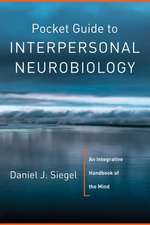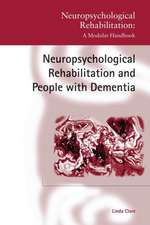The Neuropsychology Toolkit: Guidelines, Formats, and Language
Autor Richard L. Wanlassen Limba Engleză Paperback – 23 feb 2014
| Toate formatele și edițiile | Preț | Express |
|---|---|---|
| Paperback (1) | 480.83 lei 6-8 săpt. | |
| Springer – 23 feb 2014 | 480.83 lei 6-8 săpt. | |
| Hardback (1) | 584.10 lei 6-8 săpt. | |
| Springer – 7 feb 2012 | 584.10 lei 6-8 săpt. |
Preț: 480.83 lei
Nou
Puncte Express: 721
Preț estimativ în valută:
92.02€ • 95.71$ • 75.97£
92.02€ • 95.71$ • 75.97£
Carte tipărită la comandă
Livrare economică 14-28 aprilie
Preluare comenzi: 021 569.72.76
Specificații
ISBN-13: 9781489985989
ISBN-10: 1489985980
Pagini: 172
Ilustrații: XII, 160 p.
Dimensiuni: 155 x 235 x 9 mm
Greutate: 0.25 kg
Ediția:2012
Editura: Springer
Colecția Springer
Locul publicării:New York, NY, United States
ISBN-10: 1489985980
Pagini: 172
Ilustrații: XII, 160 p.
Dimensiuni: 155 x 235 x 9 mm
Greutate: 0.25 kg
Ediția:2012
Editura: Springer
Colecția Springer
Locul publicării:New York, NY, United States
Public țintă
Professional/practitionerCuprins
Part I: NeuRules: Guidelines for Improving Assessment and Reporting.- Chapter 1: Pre-Test.- Chapter 2: Interacting with Others.- Chapter 3: Managing Environmental Considerations.- Chapter 4. Obtaining and Reporting Background Information.- Chapter 5: Selecting Tests and Categorizing Performance.- Chapter 6: Testing, Interpreting, and Reporting Results.- Chapter 7: Reporting Conclusions, Diagnoses, and Recommendations.- Chapter 8: Writing Effectively.- Chapter 9: Controlling Quality.- Chapter 10: Post-Test.- Part II: Formats: Questionnaires and Reports.- Chapter 11 : Neuropsychological Questionnaire--Self-Report Version.- Chapter 12 : Neuropsychological Questionnaire--Family Report Version.- Chapter 13: Short Report Format.- Chapter 14: Long Report Format.- Part III: Language.- Chapter 15: Validity.- Chapter 16: Test Results.- Chapter 17: Conclusions.- Chapter 18: Recommendations.- Appendix: Scoring Key.- Index.
Recenzii
From the reviews:
“The Neuropsychology Toolkit: Guidelines, Formats, and Language provides the beginning clinician with the necessary and fundamental components of writing a concise, coherent, and interpretable neuropsychological evaluation. … Throughout the book, Wanlass makes extensive use of clinical examples for a range of situations that might be encountered during the neuropsychological assessment process. … this book can be recommended to the beginning clinician or doctoral student who is pursuing a career in clinical neuropsychology or to clinicians who are unfamiliar with neuropsychological assessment.” (Benjamin D. Hill and Joshua S. Kline, Journal of Child and Family Studies, Vol. 22, 2013)
“The author provides the reader with essential scaffolding on what to include in a report and helpful suggestions on how the entire evaluation process might be accomplished. Although it is primarily geared toward trainees that are earlier on in their professional development in the practice of clinical neuropsychology, the book can also be utilized by more seasoned users in a review of sound practice fundamentals. … this is a useful little book that will easily find a place on students’ or supervisors’ shelf.” (John E. Beauvais, Sara E. Anderson and Katherine D. Kane, Archives of Clinical Neuropsychology, November, 2012)
“The Neuropsychology Toolkit: Guidelines, Formats, and Language provides the beginning clinician with the necessary and fundamental components of writing a concise, coherent, and interpretable neuropsychological evaluation. … Throughout the book, Wanlass makes extensive use of clinical examples for a range of situations that might be encountered during the neuropsychological assessment process. … this book can be recommended to the beginning clinician or doctoral student who is pursuing a career in clinical neuropsychology or to clinicians who are unfamiliar with neuropsychological assessment.” (Benjamin D. Hill and Joshua S. Kline, Journal of Child and Family Studies, Vol. 22, 2013)
“The author provides the reader with essential scaffolding on what to include in a report and helpful suggestions on how the entire evaluation process might be accomplished. Although it is primarily geared toward trainees that are earlier on in their professional development in the practice of clinical neuropsychology, the book can also be utilized by more seasoned users in a review of sound practice fundamentals. … this is a useful little book that will easily find a place on students’ or supervisors’ shelf.” (John E. Beauvais, Sara E. Anderson and Katherine D. Kane, Archives of Clinical Neuropsychology, November, 2012)
Notă biografică
Richard Wanlass, Ph.D., is Chief Psychologist and Clinical Professor in the Department of Physical Medicine and Rehabilitation at the University of California, Davis, Medical Center, where he oversees and provides neuropsychological, psychological, and social services to patients with TBI, chronic pain, stroke, spinal cord injury, and other neurological and physical disabilities. In addition, he trains pre-doctoral psychology interns and post-doctoral neuropsychology fellows. Prior to joing UC-Davis, he directed neuropsychological and psychological services in a free-standing brain injury rehabilitation facility. Other previous activities include private practice, consultation, and service as an Expert Reviewer for the California Board of Psychology. Dr. Wanlass is a Fellow of the National Academy of Neuropsychology and a member of the American Psychological Association.
Textul de pe ultima copertă
Many outcomes may hinge on a neuropsychology evaluation, from the awarding of money to the granting of custody. Assessment of mental, motor, and related functions must be accurate and results reported in clear detail to contribute to an informed judgment. For the practitioner just starting to compose evaluation reports, this can be a daunting prospect, especially if one is still mastering the language of the field and its clinical nuances.
The Neuropsychology Toolkit jump-starts confidence and competence by identifying common evaluation errors—of omission, commission, and misjudgment—and providing a solid framework for avoiding them. Geared toward best practice as well as clear communication, it covers each step of the process, from gathering background information and other pre-test considerations to interpreting results and reporting conclusions, so the developing practitioner can find his or her own voice without sacrificing crucial detail. This improved evaluation of clients, in turn, will improve the way one’s practice is evaluated by supervisors, colleagues, or the courts.
Concise and practical, The Neuropsychology Toolkit is a trustworthy reference for neuropsychologists, clinical psychologists, and rehabilitation specialists.
The Neuropsychology Toolkit jump-starts confidence and competence by identifying common evaluation errors—of omission, commission, and misjudgment—and providing a solid framework for avoiding them. Geared toward best practice as well as clear communication, it covers each step of the process, from gathering background information and other pre-test considerations to interpreting results and reporting conclusions, so the developing practitioner can find his or her own voice without sacrificing crucial detail. This improved evaluation of clients, in turn, will improve the way one’s practice is evaluated by supervisors, colleagues, or the courts.
Concise and practical, The Neuropsychology Toolkit is a trustworthy reference for neuropsychologists, clinical psychologists, and rehabilitation specialists.
Caracteristici
Concise, practical manual for improving the quality of neuropsychological evaluations Long and short report formats and sample wording are tremendous time savers Fills the gap between academic neuropsychology instruction and real-world practice Appendices include neuropsychological questionnaire, short- and long-report formats, and sample statements for sections of the neuropsychological report that are especially challenging to write Includes supplementary material: sn.pub/extras














